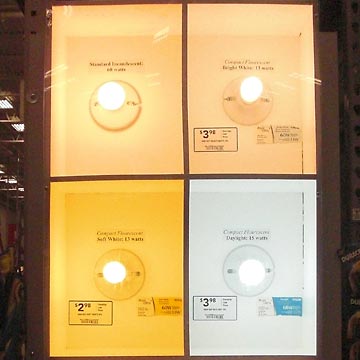OCTOBER 2, 2009
Compact fluorescent (CFL) update
For the past year or two I've been buying 6-packs of 60 and 100-watt equivalent Compact Fluorescent Lights (CFL). As our standard bulbs burn out they get replaced by the much more energy-efficient CFLs. At this point about 80% of our lighting is supplied by CFLs.
 Today's trip to my local Lowe's store showed me a couple of new things.
Today's trip to my local Lowe's store showed me a couple of new things.
I still hear complaints about the quality of light from CFLs, which always surprises me. Early versions had a bluish cast, but newer CFLs have a warm light that to my eye is the same as an old-fashioned incandescent.
CFLs now come in different color "temperatures" so you can even choose a warmer or a whiter light. At Lowe's an in-store display shows this clearly.
Top left is a standard 60-watt incandescent bulb and to its right is a 13-watt Bright White CFL. They both emit a pinkish-yellow light. The second row has an even warmer (yellower) Soft White CFL at left and a true white Daylight CFL at right.
So I don't want to hear any more excuses about how the light from CFLs to too "cold." Pick the degree of warmth or coolness you prefer.
They don't fit my light fixture!
 In the old days CFLs were big and bulky, unsuitable for some lamps and fixtures. Not anymore. The new twisty CFLs are sometimes even smaller than incandescents. You can get them with plastic globes over the twisty part that will work with snap-on lamp shades.
In the old days CFLs were big and bulky, unsuitable for some lamps and fixtures. Not anymore. The new twisty CFLs are sometimes even smaller than incandescents. You can get them with plastic globes over the twisty part that will work with snap-on lamp shades.
And for fixtures that require bulbs with a smaller "chandelier" base, like the 3-light model I just bought for the overhead fan in my kitchen, you can get 'em. These Sylvania models should work just fine.
More about CFLs and saving energy
Energy-efficiency and lighting—December 20, 2007
How you can fight global warming—September 27, 2007
One Billion Bulbs—February 8, 2007
Top |
|
![]()
